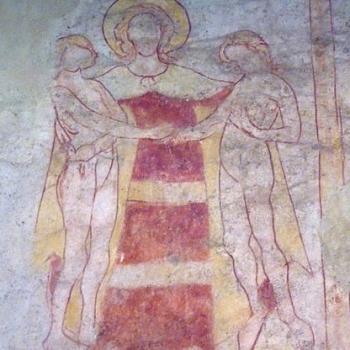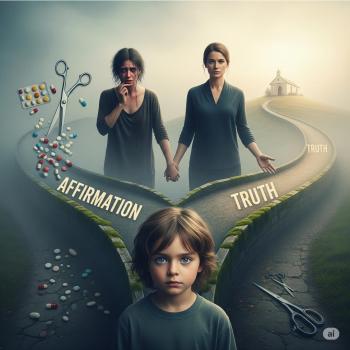
Most Saturday mornings, I attend a Catholic men’s group at a local donut shop. During a recent meeting, a fellow member presented the group with a tiny rubber figure (see attached photo)—a 12-week-old (in utero) pre-born baby. At first glance, the figure is shocking. At 12 weeks, we already possess all our human features. The figure clearly depicts eyes, ears, a nose, mouth, hands, and feet.
Moreover, I couldn’t help but see myself at that stage of development. Do you? If not, why not?
In this article, I present facts about human development and arguments against the intentional killing of pre-born humans. My goal is to encourage discussion and perhaps a bit of discomfort. Of all the dangerous places in the world, a mother’s womb should not be one of them.
Human Development
For a full review of prenatal development, please watch the video linked [here].
- A new, genetically unique human being comes into existence.
- Genetic traits like eye color and sex are set.
- The genome activates, and the human begins to develop.
- The heart begins to beat.
- Blood circulates through the body.
- Brain growth accelerates.
- Eyes begin to form.
- Arms and leg buds appear.
- Detectable brainwaves emerge.
- The heart matures.
- Bones begin to form.
- In females, ovaries appear.
- The unborn sigh, suck, swallow, and stretch.
- The sense of touch begins to develop.
- Vocal cords form.
- The unborn display complex facial expressions.
- The lips and nose finish developing.
- The intestines begin absorbing glucose and water.
- Genitalia become distinguishable.
- The mother begins to feel movement (quickening).
- Teeth begin to form.
- The four lobes of the cerebral cortex develop.
- The fetus shows a hormonal stress response to pain.
- REM sleep occurs, suggesting dreaming.
- The fetus reacts to noise (blink-startle response).
- Breathing motions draw amniotic fluid into the lungs.
- The adrenal glands produce large amounts of steroids daily.
- Breathing motions increase to 30–40% of the time.
- Alveolar duct cells begin forming air pockets.
- Significant weight gain occurs.
- The eyes grow.
- The brain contains nearly all the neurons it will ever have.
Highlights
Key takeaways stand out. At conception, a genetically unique human being begins to exist. By six to seven weeks, brainwaves are detectable. By birth, the brain holds nearly all its lifelong neurons.
Arguments Against Abortion
The SLED Argument (Size, Level of Development, Environment, Degree of Dependency)
Philosopher Stephen Schwarz developed this argument:
Size: Yes, embryos are smaller than newborns and adults. But why should size determine value? Men are generally larger than women—should they have more rights? Size doesn’t equate to worth.
Level of Development: Embryos are less developed than adults—but so are toddlers compared to teenagers. If self-awareness defines personhood, then newborns, those asleep, or people with Alzheimer’s wouldn’t count as valuable humans either.
Environment: Where someone is doesn’t change who they are. If moving from the womb to the outside world doesn’t alter one’s essence, how can it alter one’s value?
Degree of Dependency: Many people rely on medications or medical devices. Are they less human? What about conjoined twins? Dependency doesn’t negate personhood.
In short, while humans differ in development, ability, or dependency, they are equal because they share the same human nature.
To summarize, Schwarz makes the following case against abortion:
- Size: A small child is no less human than a larger one.
- Level of Development: A newborn is less developed than a teenager, but equally human.
- Environment: Changing location (inside vs. outside the womb) doesn’t change one’s nature.
- Degree of Dependency: Being dependent on another (like a diabetic on insulin) doesn’t eliminate personhood.
The Equal Rights Argument
Major Premise (P1): All human beings have equal moral status and an equal right to life, based on our shared human nature.
Minor Premise (P2): Embryos and fetuses are human beings with the same nature.
Conclusion (C): Therefore, they have equal moral status and the same right to life.
Peter Kreeft’s Hunter Analogy
Imagine you’re hunting with a friend and get separated. You hear rustling in the bushes but can’t see what’s there. Do you shoot, hoping it’s a deer? Or do you wait, unsure if it’s your friend? Abortionists face a similar choice daily. They cannot say for certain that the fetus is not a human being—but they act anyway. They risk committing murder.
Kreeft’s Argument in Syllogistic Form:
P1: If there’s uncertainty about whether a being is a person, one must not risk unjustly killing it.
P2: In abortion, there is often uncertainty about the fetus’s personhood.
C: Therefore, one must not abort, as it risks unjustly killing a human person.
Final Thoughts…
I hope readers take a moment to reflect on the image of that small, rubber figure. Consider the facts about human development and the arguments presented here. If you disagree, I welcome your challenges. Let’s have the conversation.
Thank you!
If you liked this article, please leave your comments below. I am very interested in your opinion on this topic.
Read The Latin Right’s other writing here.
Please visit my Facebook page and IM your questions (and follow my page) or topics for articles you would like covered.
Also, please subscribe my YouTube page for updates on upcoming articles.













